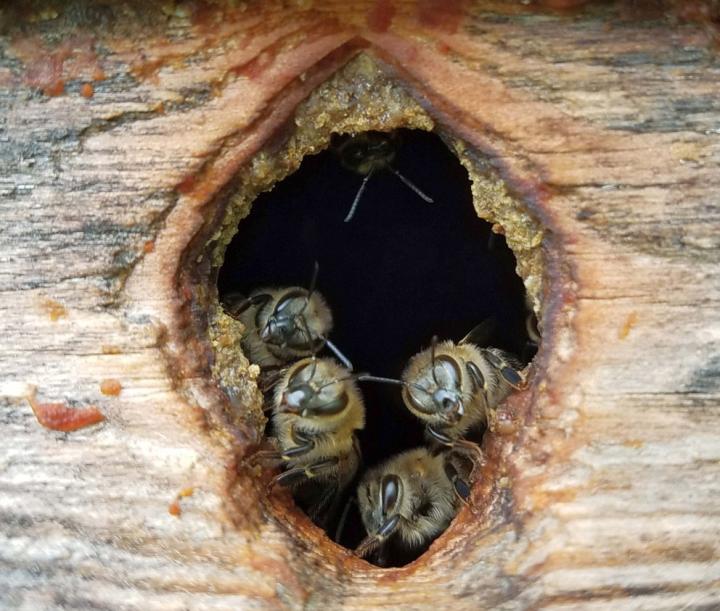
Credit: Katy Evans, Penn State
Understanding the genetic and environmental factors that enable some feral honey bee colonies to tolerate pathogens and survive the winter in the absence of beekeeping management may help lead to breeding stocks that would enhance survival of managed colonies, according to a study led by researchers in Penn State’s College of Agricultural Sciences.
Feralization occurs when previously domesticated organisms escape to the wild and establish populations in the absence of human influence, explained lead researcher Chauncy Hinshaw, doctoral candidate in plant pathology and environmental microbiology.
“In the case of honey bees, colonies that escape domestication and establish in the wild provide an opportunity to study how environmental and genetic factors affect the fitness of feral organisms compared to their domesticated counterparts,” Hinshaw said. “Some have suggested that the artificial selection associated with domestication of honey bees has decreased their fitness and has made managed colonies vulnerable to pests and pathogens.”
Feral honey bees frequently interact with both managed and wild bee species, playing a critical role in the dynamics of pathogens that are shared among these closely related groups, noted study co-author Margarita López-Uribe, assistant professor of entomology and Lorenzo L. Langstroth Early Career Professor.
“Both domesticated and feral honey bees face serious challenges from a large number of pests and pathogens, but feral honey bees must deal with diseases by themselves since they don’t have beekeepers helping them control pest problems in the colony,” she said. “This makes honey bees an ideal model to investigate the hypothesis that host-pathogen dynamics during feralization can result in higher disease pressure and pathogen tolerance in feral organisms.”
The research team set out to answer three questions: Are feral colonies reservoirs of pathogens, with high pathogen levels compared to managed colonies? Do increased pathogen levels lead to higher expression of immune genes in feral colonies than in managed colonies? Is immune gene expression correlated with survival of honey bee colonies?
To address these questions, the researchers partnered with beekeepers to locate 25 feral honey bee colonies across Pennsylvania and paired each of those colonies with a managed colony within a seven-mile radius to control for climate and landscape variation. The team surveyed these colonies over a two-year period to measure winter survival, levels of three pathogens — deformed wing virus, black queen cell virus and Nosema ceranae — and expression of six genes that regulate immunity.
Deformed wing virus, or DWV, is considered the most serious honey bee viral pathogen because of its prevalence worldwide and its role in winter losses of colonies. DWV and other viruses often are spread by parasitic Varroa mites, requiring beekeepers to implement management strategies to minimize mite infestations among their bees.
The team’s findings, recently published in Frontiers in Ecology and Evolution, indicated that feral colonies had higher levels of DWV, but it was variable over time compared to managed colonies. In addition, higher pathogen levels were associated with increased immune gene expression, with feral colonies showing higher expression in five of the six examined immune genes for at least one sampling period.
“We also found that differential expression of the immune genes hymenoptaecin and vago increased the odds of overwintering survival in both managed and feral colonies,” Hinshaw said. “As a result, these two genes could be considered biomarkers of honey bee health that can be used to predict the ability of a colony to survive the winter.”
López-Uribe said the results provide evidence for the role of feralization in altering pathogen landscapes and host immune responses.
“Our study was the first to show the association of host-pathogen dynamics with survival of feral colonies,” she said. “Further research to identify the genetic mechanisms of virus tolerance and biomarkers of bee health can help breeding efforts to enhance these traits in selected honey bee stocks, with the goal of decreasing colony losses for the beekeeping industry.”
###
Other researchers on the project were Kathleen Evans, doctoral candidate in entomology at the University of Maryland, and Cristina Rosa, associate professor of plant virology, Penn State.
The Penn State College of Agricultural Sciences’ Strategic Networks and Initiatives Program partially funded this work through the Graduate Training Program in Integrative Pollinator Ecology. The U.S. Department of Agriculture’s National Institute of Food and Agriculture also supported the research.
Media Contact
A’ndrea Elyse Messer
[email protected]
Related Journal Article
http://dx.




